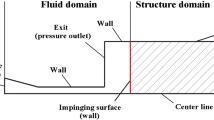Abstract
During drilling and spraying operations, the main cause of wear and even failure of spools is the impact of rock-carrying fluid on their inner wall. In order to study the erosion condition of high-speed sand-carrying liquid–solid two-phase flow on drilling spools, researchers established an erosion model by selecting a suitable erosion theory, physical model, and boundary conditions. Numerical simulation and analysis were conducted using COMSOL software to investigate the erosion effect of the spool caused by different factors, such as flow rate, particle diameter, and fluid viscosity. The research results show that the erosion rates of drilling spool calculated by Finnie model, E/CRC model, and DNV model are similar. Moreover, the erosion rate is positively correlated with inlet velocity, erosion time, particle size, and particle mass flow rate; and negatively correlated with fluid viscosity. Therefore, in actual drilling operations, it is important to ensure drilling fluid performance and rock debris mass flow rate to carry out safe drilling operations.























Similar content being viewed by others
References
X. Penghai, Z. Sha, Y. Shuangbao, S. Biao, W. Weiwei, Integrated wellhead four way device for drilling and production of high-pressure open hole oil and gas wells Testing of oil and gas wells 27, 33–38 (2018)
Z. Ahmad, B.J. Abdul Aleem, Degradation of aluminum metal matrix composites in salt water and its control. Mater. Eng. 23, 173–180 (2002)
W. Lee, S. Pyun, Effects of sulphate ion additives on the pitting corrosion of pure aluminum in 0.01 M NaCl solution. Electrochim Acta. 45, 1901–1910 (2000)
He. Jianghua, L. Huixin, Ai. Zhijiu, W. Shuang, Improvement of multi-functional spool erosion-resistant structure in air drilling. Pet. Mach. 42(04), 7–10 (2014)
C. Dongbo, Z. Enbo, L. Shuanggui, L. Dandan, Z. Hongjun, Z. Dezhi, Erosion resistance of drilling manifolds under emergency spray conditions. Corros. Prot. 39(09), 698–703 (2018)
L. Ming, Z. Chuan, J. Faguang, L. Yong, Z. Min, Li. Xin, Prediction of erosion in frac manifold based on flow field analysis. Oil Field Equip. Mater. 49(02), 21–26 (2020)
W. Shengbin. Research on the erosion mechanism of gas drilling wellhead equipment. Southwest Petroleum University, 2015.
Y. Jie. Study on the properties of Inconel625 nickel-based alloy deposited on the surface of 30CrMo steel. Lanzhou University of Technology 2011.
J.X. Zhang, Y.Q. Bai, J. Kang, X. Wu, Failure analysis and erosion prediction of tee junction in fracturing operation. J Loss Prevent Proc. 46, 94–107 (2017)
Y. Zhang, B.S. McLaury, S.A. Shirazi, Improvements of particle near-wall velocity and erosion predictions using a commercial CFD code. J. Fluids Eng. Trans. ASME. 131, 313031–313039 (2009)
Z. Hongwei, W. Shuang, C. Xijun, T. Yun, C. Xiwei, M. Zhangzhi, Calculation and prediction of erosion and wear of multifunctional spool in air drilling. Pet. Mach. 42(09), 35–39+104 (2014)
A. Mansouri, H. Arabnejad, S.A. Shirazi, B.S. McLaury, A combined CFD/experimental methodology for erosion prediction. Wear. 332–333, 1090–1097 (2015)
Y.I. Oka, K. Okamura, T. Yoshida, Practical estimation of erosion damage caused by solid particle impact: part 1: effects of impact parameters on a predictive equation. Wear. 259, 95–101 (2005)
H. Zhu, J. Zhu, R. Rutter, H. Zhang, A numerical study on erosion model selection and effect of pump type and sand characters in electrical submersible pumps by sandy flow. J. Energy Res. Technol. Trans. ASME. 141, 12 (2019)
Y. Zhang, E.P. Reuterfors, B.S. McLaury, S.A. Shirazi, E.F. Rybicki, Comparison of computed and measured particle velocities and erosion in water and air flows. Wear. 263, 330–338 (2007)
Author information
Authors and Affiliations
Corresponding author
Additional information
Publisher's Note
Springer Nature remains neutral with regard to jurisdictional claims in published maps and institutional affiliations.
Rights and permissions
Springer Nature or its licensor (e.g. a society or other partner) holds exclusive rights to this article under a publishing agreement with the author(s) or other rightsholder(s); author self-archiving of the accepted manuscript version of this article is solely governed by the terms of such publishing agreement and applicable law.
About this article
Cite this article
Li, Q., Guan, Z., Xu, Y. et al. Research on the Erosion Resistance of High-Pressure Liquid–Solid Two-Phase Flow Junction Drilling Spool. J Fail. Anal. and Preven. 23, 2244–2259 (2023). https://doi.org/10.1007/s11668-023-01752-2
Received:
Revised:
Accepted:
Published:
Issue Date:
DOI: https://doi.org/10.1007/s11668-023-01752-2




